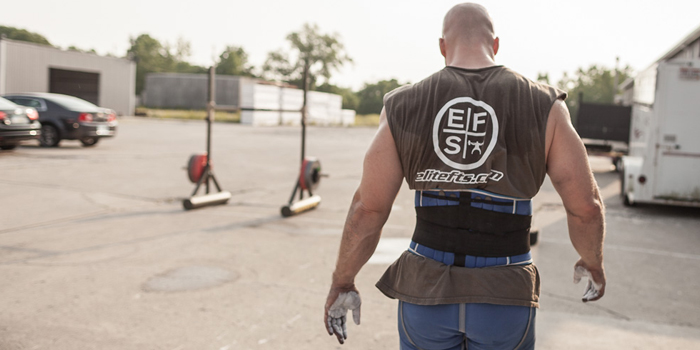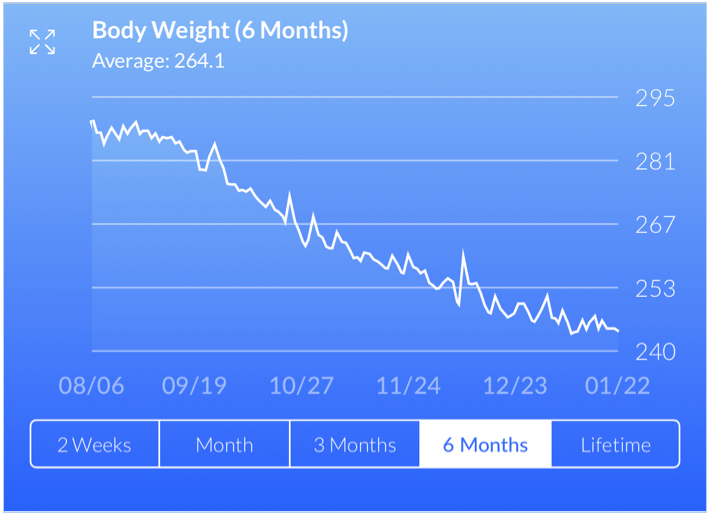
“Chase two hares, catch neither.” — Old English Proverb
Everything in this article is based on anecdotal evidence. The process of losing weight while maintaining strength is often sought by individuals looking to gain a competitive edge, but it is also usually ditched at the first perception of declining performance. There are many reasons for this, but the biggest is strength loss. Why would a strength athlete continue down a path that is leading to strength loss? The following is insight as to why that happens, what you can do to combat it, and how looking at the long-term process can help you reach your goals. For more information on the background to this article, read about my initial weight loss working with Dr. Trevor Kashey.
Weight cutting to increase relative performance is nothing new. Powerlifters or strongman will cut a lot of weight to get on the platform and then crush PRs, upping their status in their given sport. However, what we don’t always see are the behind-the-scenes factors that accompany such a quick transformation. Just to address the elephant in the room, it is a lot easier to cut weight and maintain strength and muscle mass while using PEDs. Ethics aside, do not compare yourself to enhanced athletes or try to mimic their methods.
RECENT: Training the Atlas Stones
Strength will ebb and flow during any training cycle. This is normal. Don't be surprised if anyone during a fat loss phase is hypersensitive to these changes. Like any other progression in athletics, nothing is linear. Strength and bodyweight will undulate, but being patient and waiting for it to come back to a peak from a valley will be the key to long-term success. It's important to have realistic expectations, especially in regard to how much muscle you actually have. Are you looking for a 16-week fix, or are you willing to take a year or two to reach a goal weight, maintain as much strength and muscle as possible, and then build it right? The former is much less likely to help you reach your performance goals than the latter. Being able to realistically look at your goals and then plan out how far you’re willing to go for them will set you up for success in the future.
One thing to realize is that, as your body composition changes, you will see dips in your strength. Those dips are only temporary. Leverages change, and you have to create new movement patterns. There becomes a disconnect between how much muscle you have, how strong you are, and the change in mechanics. Those decreases in performance are only temporary. If your relative rate of perceived exertion (RPE) seems high that week, drop the weight on the lift and work on nailing that technique down that day. In a week or two, it’ll be like you never missed a beat. Patience is the key here. Remember, we’re talking about long-term success. I’ve dropped 50 pounds (about 18% of my overall body mass) over the last few months, with an overall strength decrease of about five percent. There have been dips where a warm-up weight may have buried me, but as I’ve kept track of my metrics, the relative changes are in my favor.
Long-term measurement is the key point to all of this. If you’re a 270-pound athlete and you’re looking to compete at 231 pounds, that’s a 39-pound drop. And if we’re being even more realistic, for maximum performance after the weight loss we’re going to look at getting under 231 pounds so that we don’t have weight cuts hindering performance on competition day. Realistically, we’re looking at a weight decrease down to 225 or even 220 pounds. That’s almost 50 pounds of weight lost when we reach our new set point. This is where we really need to ask ourselves if it sounds realistic to drop 50 pounds in 16 weeks. Maybe it is if you’re just looking to hit up Miami Beach and you hate yourself that much, but it doesn’t sound very palatable for the long-term. Instead of rushing it, plan out 52 or more weeks. Lofty? Sure. Worth it? Absolutely.
Planning out a year or more in order to reach your goals will add a lot of value to the process. One thing you’ll be able to do is build the actual skill of weight loss. The slower you lose weight, the more likely you'll build the habits to maintain the weight loss. Yes, it is a skill. Meal prepping, tracking macros, being able to recognize and predict strength fluctuations, being able to understand how your body reacts to “going off the wagon”, etc. are all keys to a successful long-term plan. These are skills that need to be built upon. While meal prepping and tracking macronutrients are obvious portions of a body composition change, being able to make predictions about strength fluctuations is crucial in being able to maintain motivation as you drop body fat. When I start getting down to about seven or eight pounds lower than my previous bodyweight average (as graphed above), I know I’m going to see a change in leverages and a strength decrease. This helps me plan out a macrocycle for my training based on a predicted weight decrease.
RELATED: A Bodybuilding Diet for Powerlifters: How to Eat to Build Muscle and Get Strong
If you’re working with a nutritionist and a strength coach, these sorts of predictions can also come in handy because they will help negate any confusion between the two coaches, which can often lead to the blame game. Knowing that you’re going into a program with a long-term goal, and then being able to share information with both coaches and understand that you’re in a period of fluctuation, can be invaluable to long-term success.
Obviously, as you go further down the road in your pursuit, you’re going to have to adjust your training and lifestyle in order to meet goals. How do we go about doing that? The goal during recomposition should be to maintain strength and performance. I prefer increasing frequency and intensity while decreasing volume. With these changes, we can continue to build new patterns as leverages change while also maintaining muscle mass.
I won’t dive too far into this, as I’m sure you could read a dozen things from John Meadows or Shelby Starnes on nutrient timing, but keeping your carbs based around your training will do two things that I have noticed with myself and with clients. First, it will help you get through workouts on a caloric deficit. You still need to train hard, and even though the volume is lower, the intensity will still be high. Second, it will help maintain motivation. Nothing can derail motivation like having a huge gut bomb before bed and then waking up and looking in the mirror or stepping on the scale. While an extremely visceral reason, it is one I have noticed that can derail progress.
The last point I want to make is that it’s going to be difficult. It can be extremely simple, but it will be difficult. You’re going to be tired, you’re going to lose motivation, and you’re going to feel yourself going backward sometimes. But that comes with every endeavor. This is why it is so important to develop the skills mentioned earlier. In the words of Dr. Kashey, if it’s measurable, it’s manageable. Being able to predict when you’re going to have a down week and adjusting to it will help keep you on track. Realizing that it probably isn’t the programming but just a change in leverages or a stressful week will help you get through a plateau. Understanding the long-term process and realizing that you’re probably not going to smash any records while trying to cram 50 pounds of weight loss into your next meet training cycle will help you avoid any disappointments that may come with not meeting your performance goals.
Create a plan, give yourself ample time, measure your progress and regress, and work on those skills diligently. When you get to your goal “set point” then it’s time to rebuild. You’ll find it easier to gain strength and all that hard work will pay off. Happy dieting.











